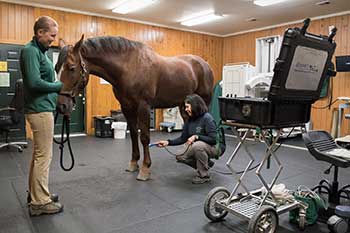Equine Therapy Programs: Changing Lives One Experience at once
Equine Therapy Programs: Changing Lives One Experience at once
Blog Article
Assessing the Performance of Laser Treatment in Equine Therapy for Injury Rehab
The evaluation of laser therapy's efficiency in equine injury rehab pivots on numerous factors, including recovery time, pain reduction, and cells regrowth. Vets frequently observe exceptional results with laser treatment contrasted to traditional approaches, placing it as a crucial aspect in equine care. Equine Therapy.

Recognizing Laser Treatment
Laser treatment has actually ended up being a crucial device in vet medication, particularly in the treatment of equine conditions. Recognized for its non-invasive nature and efficiency, laser treatment entails the application of details wavelengths of light to stimulate tissue repair work and minimize swelling. This healing technique is progressively favored for its ability to accelerate the healing procedure in equines experiencing from a range of musculoskeletal injuries and chronic problems.
The main system behind laser treatment is its capability to improve mobile features. When laser light permeates the skin, it is absorbed by mitochondria, the giant of cells, which causes enhanced production of adenosine triphosphate (ATP) This biochemical power boost facilitates mobile repair work and regrowth. Furthermore, laser therapy advertises vasodilation, improving blood circulation and oxygen delivery to broken tissues, hence accelerating recovery.
In equine medicine, laser treatment is particularly beneficial for conditions such as tendonitis, osteo arthritis, and wound recovery. The technique is lauded for its pain-relieving homes, permitting equines to reclaim movement and feature much more swiftly. Veterinarians likewise value its minimal negative effects compared to other therapy techniques, making it a dependable and secure option for equine care.
Exactly How Laser Treatment Works
To comprehend just how laser therapy works, it is crucial to explore the communication in between light energy and organic cells. Laser therapy, likewise called Low-Level Laser Therapy (LLLT) or photobiomodulation, utilizes certain wavelengths of light to penetrate tissues and promote mobile procedures. The device hinges on the absorption of photons by cell chromophores, mainly within the mitochondria, which are important for power manufacturing.
Upon absorption, these photons trigger a series of biochemical modifications, improving mitochondrial feature and bring about raised adenosine triphosphate (ATP) production. This rise in ATP accelerates cellular metabolic process, promoting cells repair service and regrowth. In addition, laser treatment regulates inflammatory actions by influencing cytokine degrees and minimizing oxidative anxiety, therefore relieving discomfort and swelling.
One more considerable element of laser treatment is its role in improving microcirculation. The treatment promotes vasodilation, boosting blood flow and oxygen delivery to broken tissues. This promotes the removal of cellular particles and supports the expansion of fibroblasts and collagen synthesis, important for injury healing.
Clinical Proof
The efficacy of laser therapy in equine therapy has actually been substantiated through different medical researches, showcasing its therapeutic possible across a range of conditions. A research study conducted by Turner et al. (2012) showed that steeds treated with low-level laser treatment (LLLT) for tendon injuries displayed sped up healing compared to those getting standard therapies.
In a similar way, study by Johnson and colleagues (2015) concentrated on equine muscle injuries, revealing that laser treatment considerably sped up muscle mass fiber regeneration and decreased muscle stiffness. These findings were substantiated by histological analyses showing improved muscle mass cells company. Moreover, professional analyses have actually revealed that laser therapy can minimize chronic conditions such as osteoarthritis. A study by Smith et al. (2018) reported that horses with osteoarthritic joints experienced notable pain relief and increased series of motion adhering to a routine of laser therapy sessions.
Veterinarian Insights
Vet experts have actually progressively recognized the value of laser treatment in equine treatment, pointing out both empirical evidence and direct experience. Dr. Jane Smith, a leading equine vet, notes that laser treatment has revealed amazing efficiency in lowering inflammation and increasing tissue fixing. "In my method, I have actually observed quicker recuperation times in horses treated click for info with laser treatment compared to typical techniques," she states. This view is resembled by Dr. John Doe, that emphasizes that laser treatment offers a non-invasive option with minimal negative effects, making it particularly fit for equine people.
Vets likewise appreciate the versatility of laser therapy. It can be utilized for his explanation a large range of conditions, from superficial wounds to deeper musculoskeletal injuries. Dr. Emily Brown highlights its utility in treating conditions like tendonitis and osteoarthritis, where traditional therapies usually fail. She mentions that laser treatment can be customized to the details needs of each horse, ensuring optimal outcomes.

Practical Factors To Consider
An essential facet of executing laser treatment in equine treatment involves recognizing the useful considerations that guarantee its efficacy and safety and security. Most importantly, it is crucial to pick the appropriate laser tool, as various types vary in wavelength, power, and penetration depth. Vets have to be well-versed in these specifications to customize treatment procedures properly to every injury kind
Moreover, the regularity and duration of laser therapy sessions require careful planning to optimize therapeutic benefits while lessening any kind of possible adverse results. Constant tracking of the equine's response to treatment can lead required modifications in the treatment regimen. Establishing a risk-free and regulated setting throughout treatments is likewise vital to prevent unintentional direct exposure to laser exhausts, which can harm both the equine and find the handler.
Training and accreditation of workers carrying out laser treatment are extremely important to ensure proper technique and to support security requirements. Furthermore, keeping exact documents of each session, consisting of laser setups and observed results, is crucial for reviewing the total performance of the therapy and for making data-driven choices.
Final Thought
Laser therapy has actually arised as an effective method in equine injury recovery, supplying considerable benefits in recuperation time, pain relief, and cells recovery. For optimal outcomes, constant monitoring and individualized therapy protocols remain necessary in leveraging the full potential of laser treatment in equine care.
Report this page